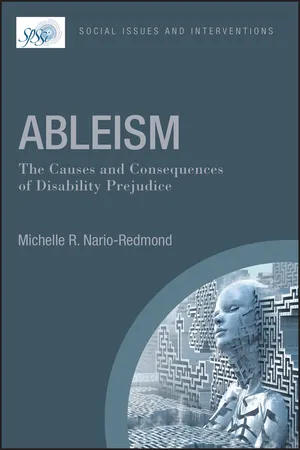
- English
- ePUB (mobile friendly)
- Available on iOS & Android
Ableism: The Causes and Consequences of Disability Prejudice
About this book
The first comprehensive volume to integrate social-scientific literature on the origins and manifestations of prejudice against disabled people
Ableism, prejudice against disabled people stereotyped as incompetent and dependent, can elicit a range of reactions that include fear, contempt, pity, and inspiration. Current literature—often narrowly focused on a specific aspect of the subject or limited in scope to psychoanalytic tradition—fails to examine the many origins and manifestations of ableism. Filling a significant gap in the field, Ableism: The Causes and Consequences of Disability Prejudice is the first work to synthesize classic and contemporary studies on the evolutionary, ideological, and cognitive-emotional sources of ableism. This comprehensive volume examines new manifestations of ableism, summarizes the state of research on disability prejudice, and explores real-world personal accounts and interventions to illustrate the various forms and impacts of ableism.
This important contribution to the field combines evidence from multiple theoretical perspectives, including published and unpublished work from both disabled and nondisabled constituents, on the causes, consequences, and elimination of disability prejudice. Each chapter places findings in the context of contemporary theories—identifying methodological limits and suggesting alternative interpretations. Topics include the evolutionary and existential origins of disability prejudice, cultural and impairment-specific stereotypes, interventions to reduce prejudice, and how to effect social change through collective action and advocacy. Adopting a holistic approach to the study of disability prejudice, this accessibly-written volume:
- Provides an inclusive, up-to-date exploration of the origins and expressions of ableism
- Addresses how to resist ableist practices, prioritize accessible policies, and create more equitable social relations with pages earmarked for activists and allies
- Focuses on interpersonal and intergroup analysis from a social-psychological perspective
- Integrates research from multiple disciplines to illustrate critical cognitive, affective and behavioral mechanisms and manifestations of ableism
- Suggests future research directions based on topics covered in each chapter
Ableism: The Causes and Consequences of Disability Prejudice is an important resource for social, community and rehabilitation psychologists, scholars and researchers of disability studies, and students, activists, and academics across political, sociological, and humanistic disciplines.
"This book is an excellent resource for both members of the academic field and lay readers seeking to know more about disability prejudice and ways to address it."
~ Charlotte Schreyer, Syracuse University, Published onH-Disability (September 2022)
Frequently asked questions
- Essential is ideal for learners and professionals who enjoy exploring a wide range of subjects. Access the Essential Library with 800,000+ trusted titles and best-sellers across business, personal growth, and the humanities. Includes unlimited reading time and Standard Read Aloud voice.
- Complete: Perfect for advanced learners and researchers needing full, unrestricted access. Unlock 1.4M+ books across hundreds of subjects, including academic and specialized titles. The Complete Plan also includes advanced features like Premium Read Aloud and Research Assistant.
Please note we cannot support devices running on iOS 13 and Android 7 or earlier. Learn more about using the app.
Information
1
Introduction: Defining Ableism
More than one billion people in the world live with some form of disability, of whom nearly 200 million experience considerable difficulties in functioning. In the years ahead, disability will be an even greater concern because its prevalence is on the rise. This is due to ageing populations and the higher risk of disability in older people as well as the global increase in chronic health conditions such as diabetes, cardiovascular disease, cancer and mental health disorders.World Health Organization (WHO 2011, p. 5)
The Largest Minority Group: Who Qualifies?
In 2003, there were no fewer than 67 US federal statutory definitions of disability.(Krahn et al. 2015, p. S199)
Table of contents
- Cover
- Table of Contents
- Foreword
- 1 Introduction: Defining Ableism
- Ableism ~ A Poem By Maria Palacios (2017)
- 2 The Evolutionary and Existential Origins of Ableism
- When Prejudice Rears Its Ugly Head…
- 3 Justifying Ableism: Ideologies and Language
- Talk About Disability Identity
- 4 Cultural and Impairment‐Specific Stereotypes
- Fighting Pop Culture Stereotypes
- 5 Hostile, Ambivalent, and Paternalistic Attitudes and Interactions
- What to do if …
- 6 Contending with Ableism from Internalized Ableism to Collective Action
- When Good Intentions Become Ableist …
- 7 Interventions to Reduce Prejudice
- Intersectional Identity and Inclusive Activism
- 8 Beyond Contact: Promoting Social Change and Disability Justice
- Four Disabled Activists You Should Know
- Appendix: Summary of Future Research Questions
- Index
- End User License Agreement